Dark Tourism Prague offers a unique and compelling way to connect with history. SIXT.VN can help you experience this intriguing side of the city, providing convenient travel solutions. Discover historical sites linked to tragedy and loss, offering a powerful understanding of resilience and remembrance. Explore convenient travel solutions, book reliable airport transfers, and discover accommodations that fit your needs, ensuring a smooth and insightful trip.
1. Unveiling Prague’s Dark Tourism Spots in the Jewish Quarter
The Jewish Quarter in Prague holds a significant place in dark tourism Prague, offering a poignant glimpse into the past. Exploring this area reveals the hardships faced by its residents during World War II, while also showcasing the resilience of the community. The preservation of synagogues and the Old Jewish Cemetery provides a tangible connection to this history, making it a must-visit for those interested in dark tourism and Jewish heritage tours in Prague.
What should you see and do when visiting Prague’s Jewish Quarter?
Formerly Prague’s Jewish Ghetto, the Jewish Quarter, or Josefov, is surrounded by the Old Town, containing many Jewish historical sites.
-
Old-New Synagogue: Built in 1270, the oldest remaining European synagogues is believed to be the resting place of the Prague Golem.
- Location: Maiselova 18, 110 01 Josefov, Praha 1
- Cost: 200 Kč (≈ €7.8)
- Opening Hours: November to March: Sunday – Friday from 9:00 to 17:00; April to October: Sunday – Friday from 9:00 to 18:00. Closed Saturdays.
-
Old Jewish Cemetery: As one of Europe’s oldest Jewish cemeteries, this place is an incredibly important piece of Prague history.
- Location: Široká, 110 00 Josefov, Praha 1
- Cost: Included in the cost of the Prague Jewish Museum (350 Kč, approximately €13.8); it costs 50 Kč (≈ €2) for photos.
- Opening Hours: November – March, Sunday – Friday: 09.00 – 16.30; April – October, Sunday – Friday: 09.00 – 18.00 (closed Saturdays and on Jewish holidays)
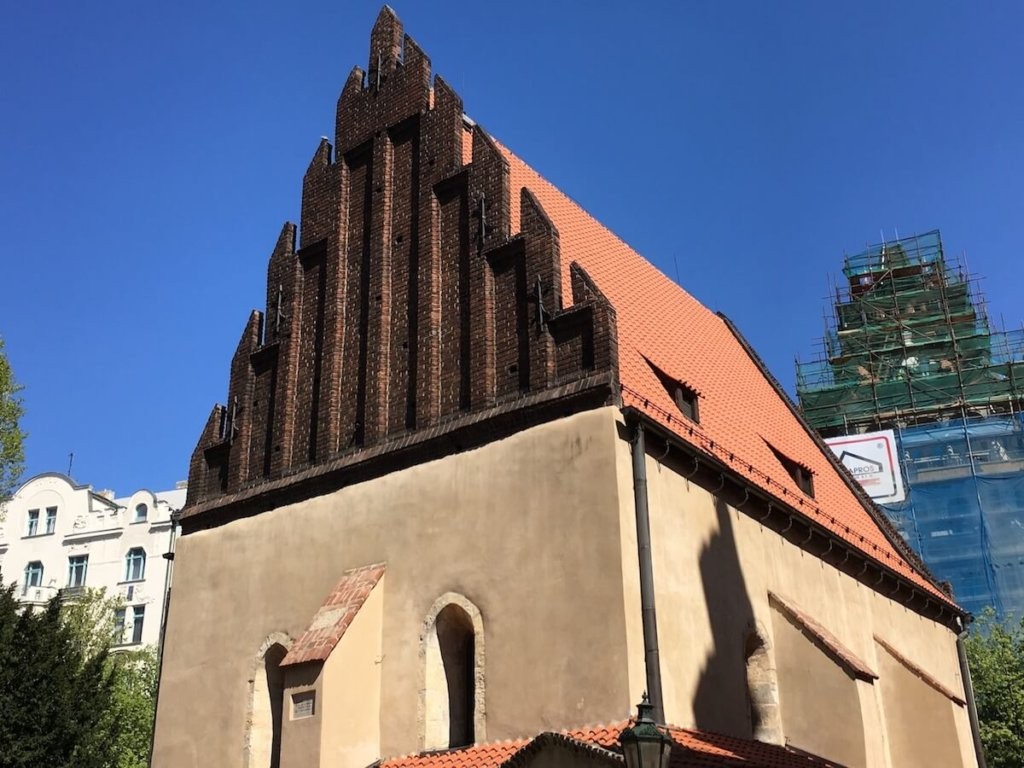 Old-New Jewish Synagogue in Prague
Old-New Jewish Synagogue in Prague -
Pinkas Synagogue: (1535) is the city’s second-oldest synagogue after the Old-New Synagogue. From 1955-1960, the Pinkas Synagogue become the Memorial to the Victims of the Shoah from the Bohemian Lands, and was one of the first memorials of its kind.
-
Maisel Synagogue: (originally built in 1592, rebuilt in 1689 after a fire, and renovated in 1893-1905). This synagogue has a permanent exhibition called Jews in the Bohemian Lands, 10th-18th Century.
-
Klausen Synagogue: (1694) The Klausen Synagogue is the largest in Prague and houses the permanent collection Jewish Customs and Traditions, Part 1.
-
Ceremonial Hall: (1912) The Ceremonial Hall was built on mortuary grounds next to the Old Jewish Cemetery and originally used to wash the dead. This site houses Jewish Customs and Traditions, Part 2.
-
Spanish Synagogue (TEMPORARILY CLOSED): (1868) This site is very impressive and unique in Prague due to its Moorish architecture and design. The synagogue is closed from June 2019 for renovations, but usually houses the following collections: The History of the Jews in Bohemia and Moravia, Part 2, Synagogue Silver from Bohemia and Moravia.
The High Synagogue (1577) used to house Hebrew books during the War and the communist rule. However, this is not open to tourists.
2. Exploring Prague’s Cemeteries: A Journey into History
With approximately 30 cemeteries within its city limits, Prague offers a rich landscape for exploring historical burial sites. These cemeteries, characterized by their beauty and tranquility, provide a unique window into the city’s past. They serve as essential stops for those interested in dark tourism Prague, offering insights into the lives and times of those who came before. You’ll find historical perspectives and reflections on mortality when you explore Prague’s cemeteries, and SIXT.VN ensures convenient access to these sites with reliable transportation options.
Which Prague cemeteries should you visit?
The city’s three most important cemeteries are the Old Jewish Cemetery in the Jewish quarter, Olšany Cemetery, and Vyšehrad cemetery.
-
Old Jewish Cemetery: The oldest surviving cemetery in the city
-
Olšany Cemetery: The largest public cemetery
-
Vyšehrad cemetery: attached to the Vyšehrad complex, and the final resting place of many famous Czechs.
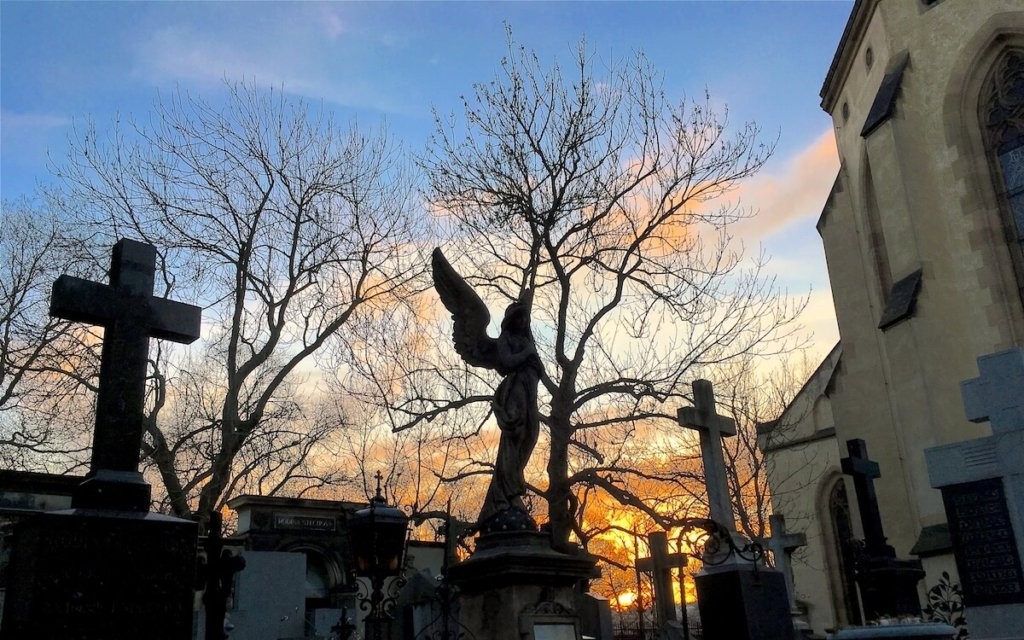 Sunset at Vysehrad Cemetery, Prague
Sunset at Vysehrad Cemetery, Prague
Other noteworthy Prague cemeteries include the Old Jewish Cemetery in Žižkov and the New Jewish Cemetery, the final resting place of Franz Kafka. The New Jewish cemetery is technically part of Olšany, but is slightly disconnected from the main cemetery.
3. What is the story behind St. Valentine’s Shoulder Blade?
The Basilica of St. Peter and St. Paul at Vyšehrad houses a relic believed to be St Valentine’s shoulder. While considered holy, the display of human remains has dark tourism appeal. This relic, rediscovered in 2002, adds a macabre layer to the saint of love. SIXT.VN ensures easy access to Vyšehrad, making it convenient to explore this unusual artifact and other historical sites.
Why is St. Valentine’s Shoulder Blade considered a dark tourism spot?
The relic is new, as it was discovered in the basilica’s vaults in 2002. During the communist era it was hidden away.
Location: Karlovo nám. 10, 120 00 Praha 2-Vyšehrad
Cost: 50 Kč
Opening Hours: November to March: Monday through Saturday: 10:00 – 17:00, Sunday: 10:30 – 17:00; April to October: Monday to Wednesday, Friday & Saturday: 10:00 – 18:00, Thursday: 10:00 – 17:30; Sunday: 10:30 – 18:00. No tourist may enter the Basilica during Mass.
4. Why are the Defenestration Towers a Key Dark Tourism Site in Prague?
The Defenestration Towers mark sites of significant historical events in Prague. These events, where individuals were thrown from windows, triggered major conflicts. The First Defenestration sparked the Hussite Wars in 1419, and the Second Defenestration led to the Thirty Years’ War in 1618. Visiting these towers offers a tangible connection to Prague’s turbulent past, making them essential for anyone interested in dark tourism Prague. SIXT.VN offers convenient transportation options to explore these historical landmarks.
What are the stories of the defenestrations of Prague?
Prague has had two official defenestrations and both had a huge impact on history.
-
The 1st Defenestration of Prague: Seven members of the Prague city council were defenestrated by Czech Hussites in 1419.
- Location: The New Town Hall, Karlovo nám. 1/23, 120 00 Nové Město, Praha 2
- Cost: Free
- Opening Hours: Can’t really go in, but you can see it from the outside at all times.
-
The 2nd Defenestration of Prague: Protestants threw several Catholic regents out of a window on 23 May 1618.
- Location: Třetí nádvoří Pražského hradu 48/2, 119 00 Praha 1-Hradčany (Czech Office, Old Royal Palace, part of the Prague Castle)
- Cost: Depends on the circuit you’re doing.
- Opening Hours: November to March: 9:00 – 16:00 (daily); April to October: 9:00 – 17:00 (daily).
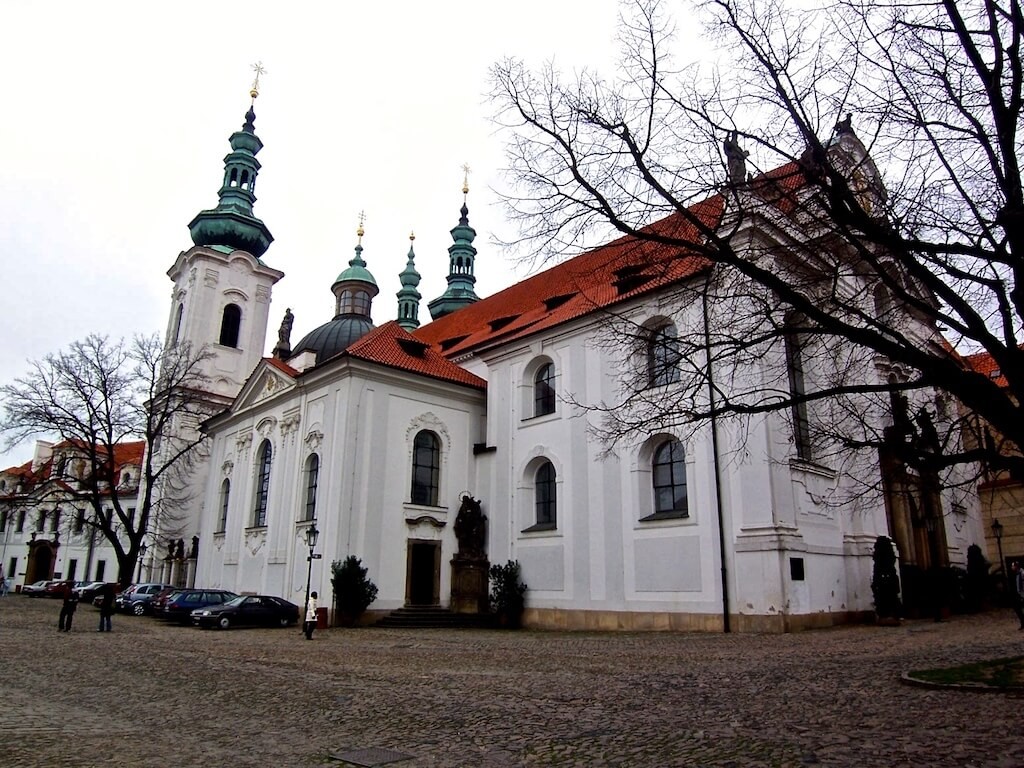 The Old Royal Palace at the Prague Castle was the site of the Second Defenestration of Prague and important moment in Prague
The Old Royal Palace at the Prague Castle was the site of the Second Defenestration of Prague and important moment in Prague
5. What is the Significance of the Old Town Square Execution Memorial?
The Old Town Square Execution Memorial commemorates the execution of 27 Czech Protestants in 1621. This event was a result of the Bohemian Revolt and highlights religious and political tensions of the time. The memorial, marked by 27 white crosses, serves as a somber reminder of this dark chapter in Prague’s history. SIXT.VN provides easy access to Old Town Square, allowing visitors to pay their respects and reflect on this significant site.
What happened at the Old Town Square Execution Memorial?
On 21 June 1621, 27 Czech Protestants were executed for their role in the Bohemian Revolt. There were three lords, seven knights and 17 townsmen; 22 Czechs and 5 Germans. Some were beheaded with swords and one of the men had his tongue cut off prior to his beheading.
Location: Staroměstské nám., 110 00 Josefov, Praha 1
Cost: Free
Opening Hours: 24/7
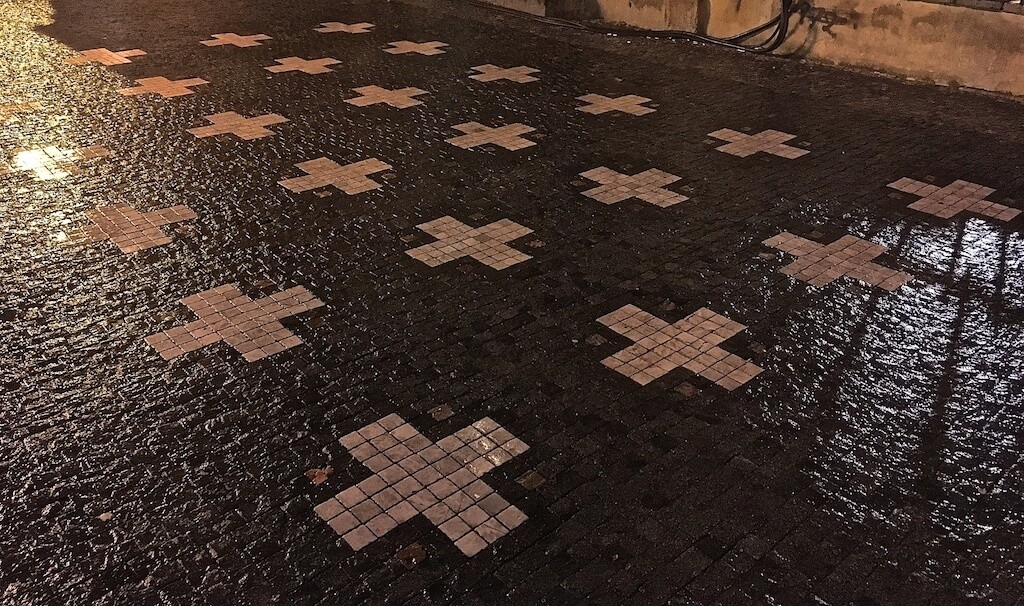 The 27 crosses in Prague
The 27 crosses in Prague
6. Charles Bridge as a Dark Tourism Destination
Charles Bridge, Prague’s iconic landmark, is more than just a beautiful structure; it’s a site with a dark past. Built in the 14th century, the bridge has witnessed numerous historical events, including the execution of Saint John of Nepomuk, who was thrown from the bridge for refusing to divulge the Queen’s confessions. The bridge’s statues, predominantly of saints, add to its historical and cultural significance, making it a compelling destination for those interested in dark tourism Prague.
What dark events occurred on Charles Bridge?
In the late 17th century, Charles Bridge was adorned with 30 Baroque statues. Saint John of Nepomuk was murdered for refusing to break the confidentiality of the confession. Witnesses saw five stars above the water where his casket sank, and these are depicted in gold on his statue on Charles Bridge.
Location: Karlův most, 110 00 Praha 1
Cost: Free
Opening Hours: 24/7
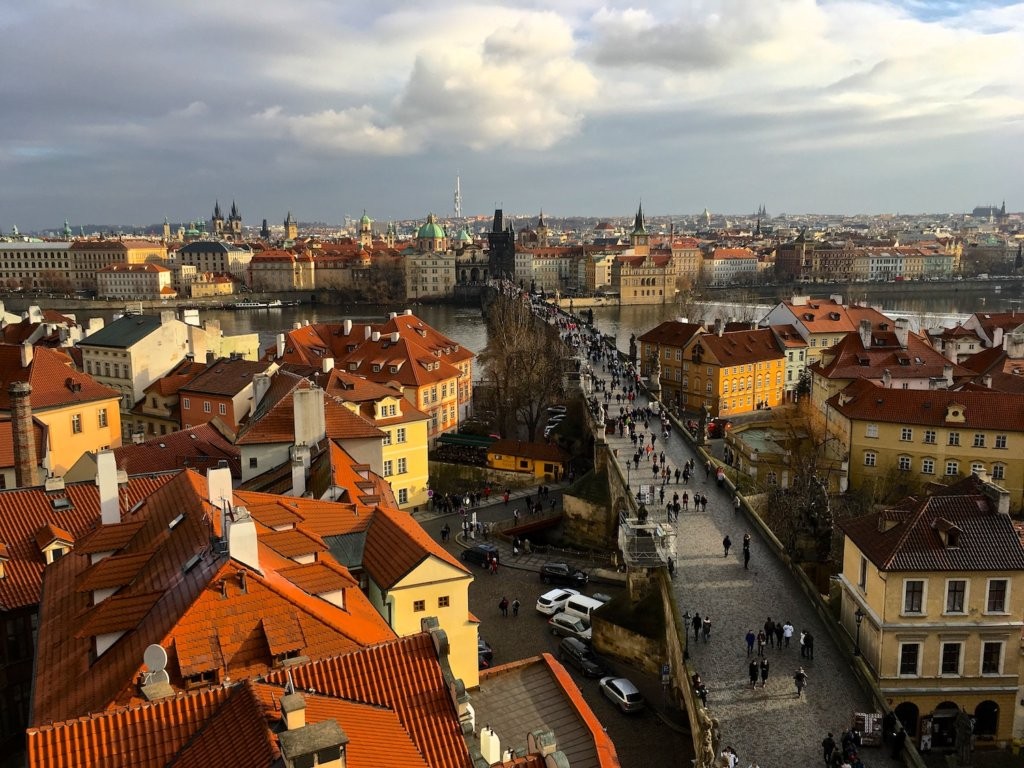 Charles Bridge in Prague, Czech Republic where 30 historic statues can be found lining the bridge across the Vltava river
Charles Bridge in Prague, Czech Republic where 30 historic statues can be found lining the bridge across the Vltava river
7. Exploring the Heydrich Terror Memorial: A Reminder of Resistance
The Heydrich Terror Memorial commemorates the assassination of Reinhard Heydrich, a high-ranking Nazi official known as “The Butcher of Prague.” The memorial, located in the crypt of the Cathedral of Saints Cyril and Methodius, pays tribute to the Czech resistance fighters who carried out the attack and the thousands of Czechs who were executed in retaliation. This site is an essential visit for those exploring dark tourism Prague, offering a profound insight into the Czech resistance during World War II. SIXT.VN ensures respectful and convenient access to this important historical site.
What is the significance of the Heydrich Terror Memorial?
On May 27 1942, Heydrich’s car was attacked. Hitler ordered thousands of Czechs be rounded up, interrogated and executed in retaliation. The towns of Lidice and Ležáky were wiped off the map. Today, the National Monument to the Heroes of the Heydrich Terror is in the crypt of the church where they hid, and died.
Location: Resslova 9a, 120 00 Nové Město, Prague
Cost: Free
Opening Hours: Tuesday – Sunday 9:00 – 17:00.
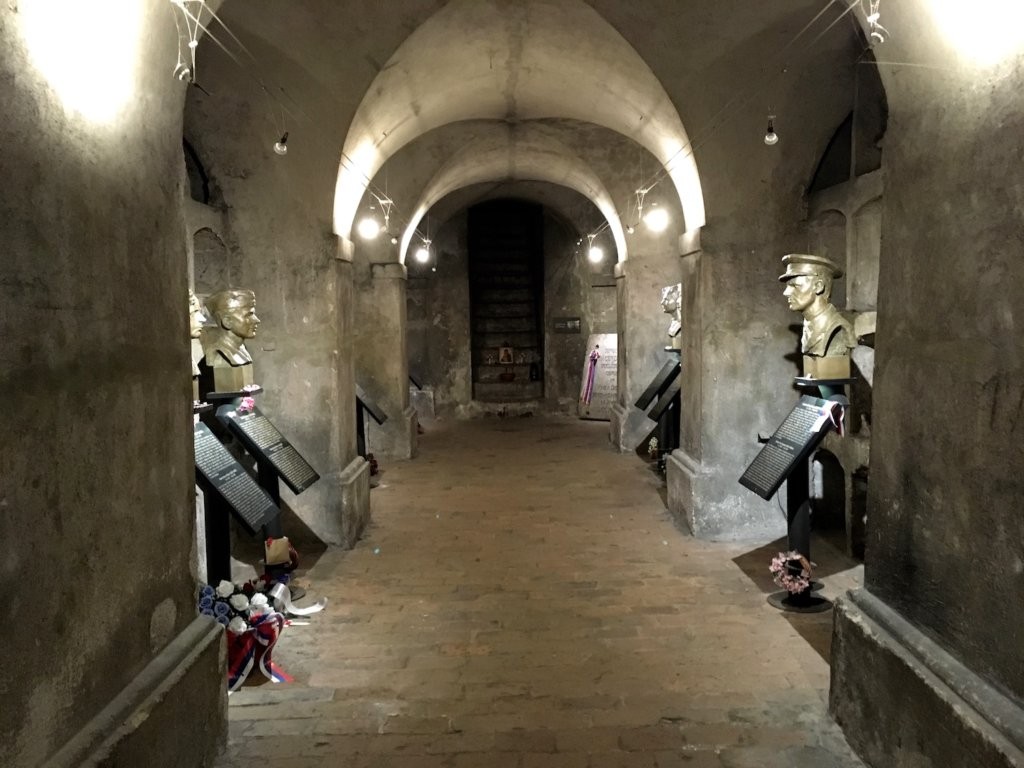 The Heydrich Terror Memorial Crypt
The Heydrich Terror Memorial Crypt
8. What Can You Expect at the KBG Museum in Prague?
The KGB Museum in Prague offers a collection of memorabilia from the communist era, including weapons, propaganda posters, and clothing. Run by a passionate owner, the museum provides a unique insight into the operations and impact of the KGB. While I couldn’t visit the Prague KGB Museum, I’ve heard excellent things (next time, right?).
What will you see at the KBG Museum?
The museum is a collection of communism era memorabilia including weapons, propaganda posters and clothing. It is run by one man who is the owner of all the material within.
9. Uncovering Prague’s Communist Past at the Museum of Communism
The Museum of Communism in Prague provides a comprehensive look into the communist regime in Czechoslovakia. Through extensive exhibits, visitors can learn about the effects of communism on daily life, politics, and culture. This museum is an important stop for those interested in dark tourism Prague, offering a deeper understanding of the city’s recent history. SIXT.VN makes it easy to include this museum in your itinerary with reliable transportation options.
Why should you visit the Museum of Communism?
It’s one of the most comprehensive museums on the communism regime you can find.
Location: V Celnici 1031/4, 118 00 Nové Město, Praha 1
Cost: 290 Kč (≈ €11)
Opening Hours: Open daily from 9:00 to 20:00.
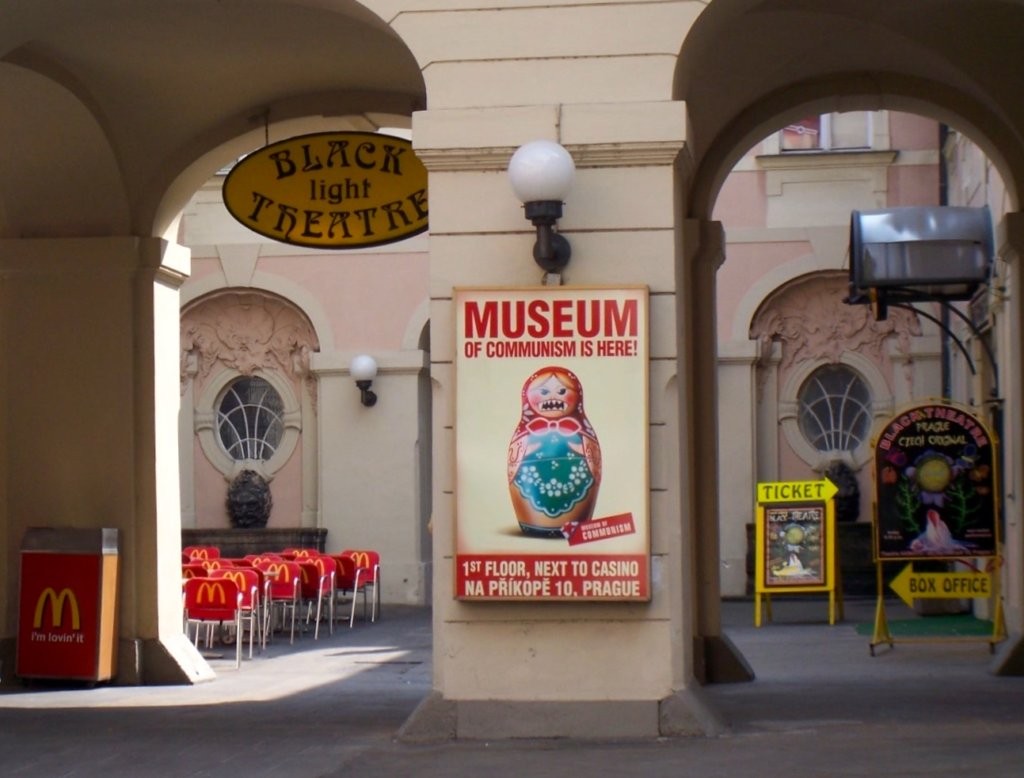 A sign for the old Communism Museum in Prague, Czech Republic depicts a Russian doll with fangs next to a Mcdonalds
A sign for the old Communism Museum in Prague, Czech Republic depicts a Russian doll with fangs next to a Mcdonalds
10. Jan Palach and Jan Zajíc Memorial: Remembering Acts of Protest
The Jan Palach and Jan Zajíc Memorial commemorates the self-immolation of two students who protested against the Soviet occupation of Czechoslovakia. Jan Palach set himself on fire in January 1969, followed by Jan Zajíc in February of the same year. These acts of protest became symbols of resistance against the Soviet regime. The memorial serves as a powerful reminder of Prague’s history of resistance, making it a significant site for those interested in dark tourism Prague. SIXT.VN ensures easy access to Wenceslas Square, where the memorial is located.
Why is the Jan Palach and Jan Zajíc Memorial important?
On 16 January 1969, 20 year old Jan Palach walked into Wenceslas Square and set himself on fire. Jan Zajíc also set himself on fire on 25 February 1969.
Location: Vinohradská, 110 00 Nové Město, Praha 1
Cost: Free
Opening Hours: 24/7
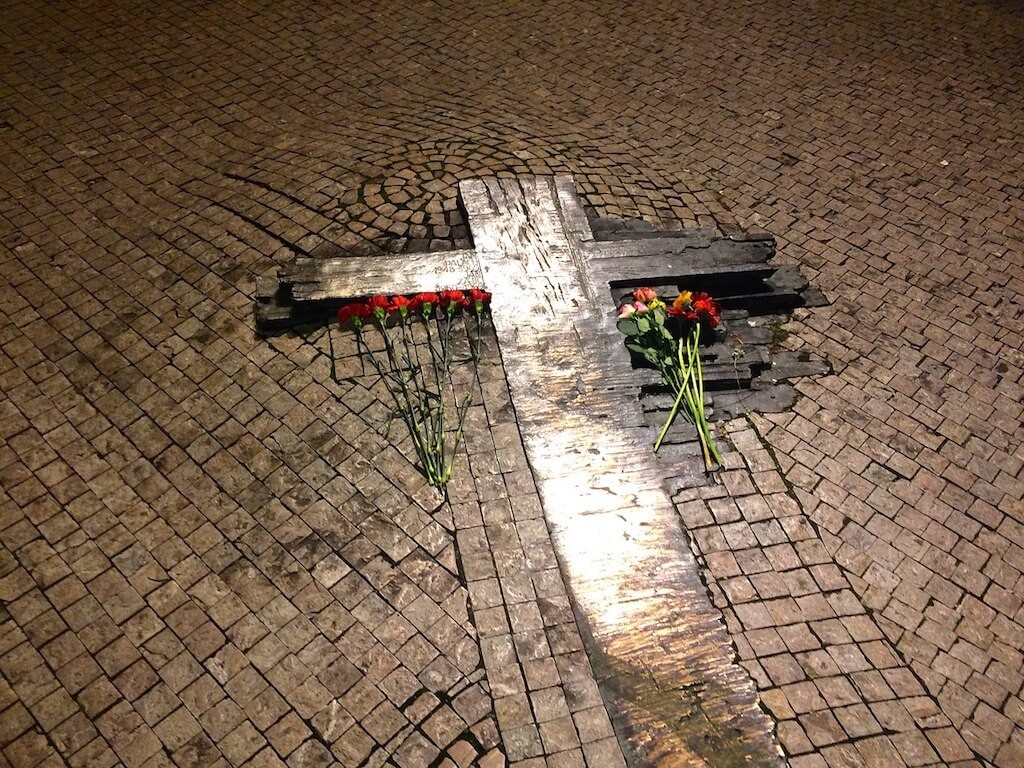 Metal cross melding into the ground with flowers. Memorial for Jan Palach and Jan Zajic on Wenceslas Square, Prague
Metal cross melding into the ground with flowers. Memorial for Jan Palach and Jan Zajic on Wenceslas Square, Prague
11. What is the Velvet Revolution Plaque?
The Velvet Revolution Plaque commemorates the events of November 17, 1989, when a student demonstration sparked a series of protests that led to the end of communist rule in Czechoslovakia. This non-violent revolution marked a significant turning point in the country’s history, leading to democratic elections and the eventual split into the Czech Republic and Slovakia.
What happened during the Velvet Revolution?
On 17 November 1989, an officially-sanctioned march was held to honour Jan Opletal. Police tried to repress the crowds, inciting an anti-communist, anti-government protest, calling for the resignation of all party leaders. By 20 November, the number of protestors had more than doubled and over 500,000 Czechs had joined their ranks. On 24 November, the entirety of the top-tier communist party leaders resigned.
Location: Národní třída, Nové Město, Prague
Cost: Free
Opening Hours: 24/7
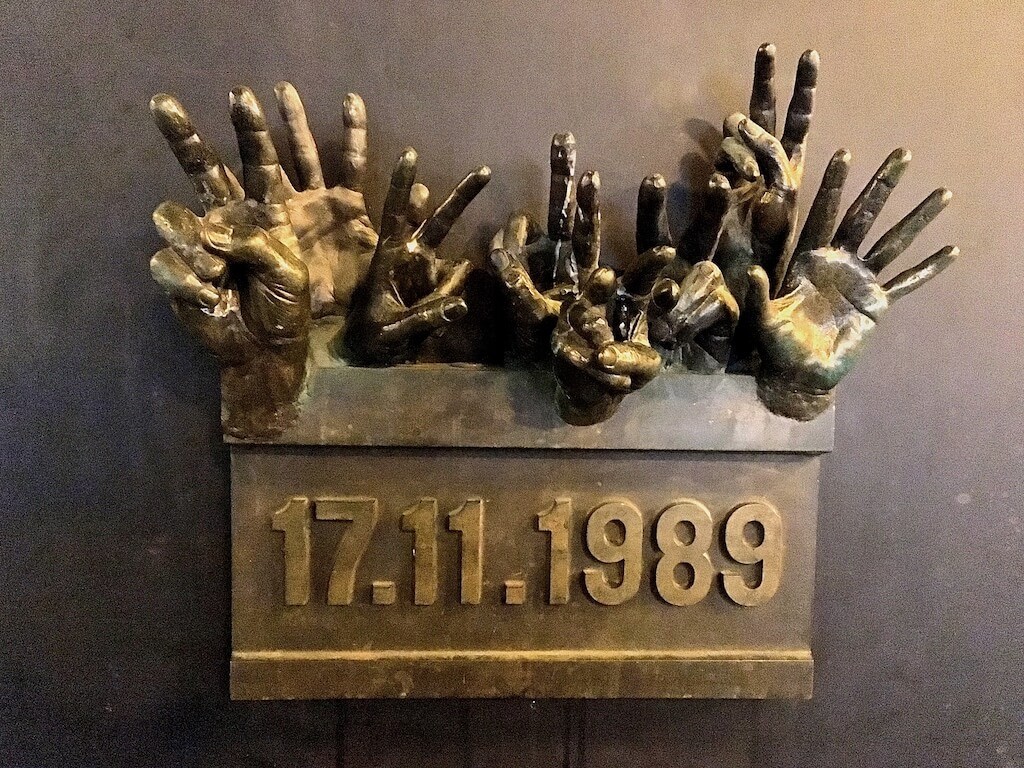 Velvet Revolution Memorial Plaque in Prague of hands hands reaching out and making peace symbols with date of 17.11.1989 beneath
Velvet Revolution Memorial Plaque in Prague of hands hands reaching out and making peace symbols with date of 17.11.1989 beneath
12. Understanding the Memorial to the Victims of Communism
The Memorial to the Victims of Communism is a haunting tribute to those who suffered under the Soviet communist regime in Czechoslovakia from 1948 to 1989. The memorial features bronze figures descending a staircase, each more fragmented than the last, symbolizing the physical and psychological toll of totalitarianism. This poignant memorial is a must-see for those interested in dark tourism Prague, offering a powerful reflection on the impact of communism.
What does the Memorial to the Victims of Communism symbolize?
The memorial is dedicated to all victims, not only those jailed or executed but also those whose lives were ruined by totalitarian despotism.
Location: Újezd 420, 118 00 Malá Strana, Prague
Cost: Free
Opening Hours: 24/7
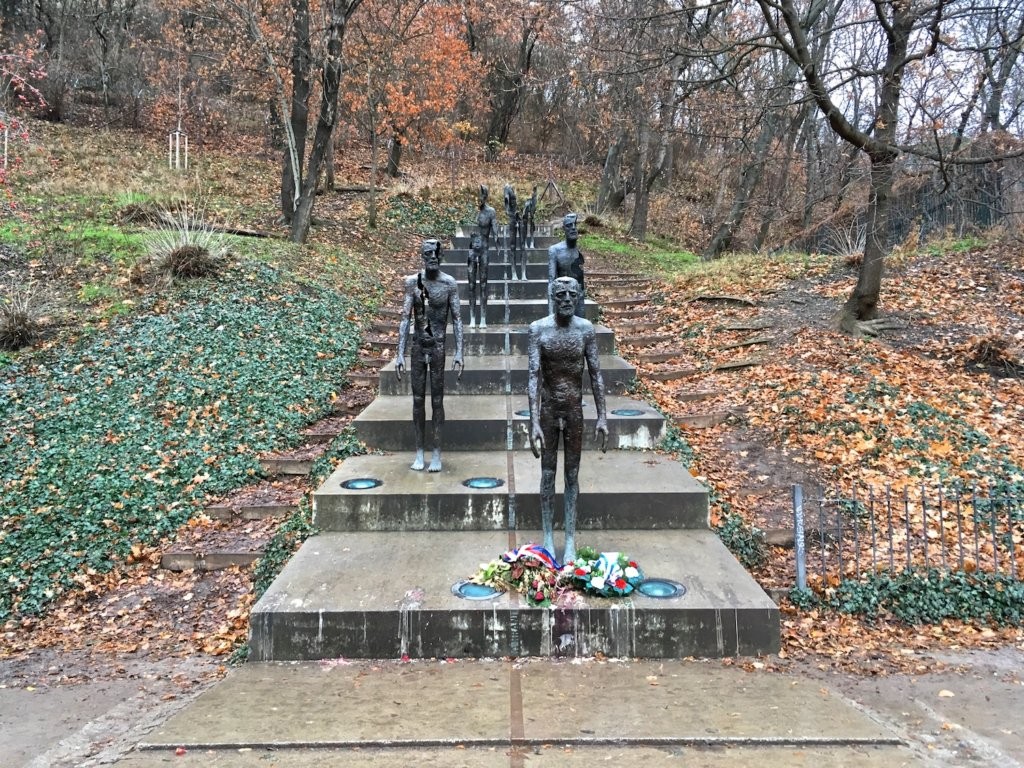 Memorial to the Victims of Communism, depicting bronze figures descending a flight of stairs, by Olbram Zoubek, Jan Kerel and Zdenek Holzel in Prague, Czech Republic
Memorial to the Victims of Communism, depicting bronze figures descending a flight of stairs, by Olbram Zoubek, Jan Kerel and Zdenek Holzel in Prague, Czech Republic
13. What is Dark Tourism in Prague’s Nuclear Bunker Tours?
Prague’s nuclear bunker tours offer a chilling glimpse into the Cold War era, when the threat of nuclear fallout was a real fear. Built in preparation for potential nuclear attacks, these bunkers provide a tangible connection to a tense period in history. Exploring these underground shelters offers a unique and unsettling experience for those interested in dark tourism Prague.
What can you expect from Prague’s Nuclear Bunker Tours?
Prague has bunkers which were built throughout the 20th century in preparation for a nuclear fallout. Prague’s primary tourist bunker is just outside of the Žižkov neighborhood, near Olšany cemetery. It has been converted into a museum of sorts and is called the Nuclear Bunker Exposition.
Location: – The Nuclear Bunker Exposition: meeting point as you typically meet away from the bunker– Folimanka Bunker: 4 1325, Vinohrady, Pod Karlovem, 120 00 Praha 2
Cost: – The Nuclear Bunker Exposition: Around €28 per person for a tour.– Folimanka Bunker: Free
Opening Hours: – The Nuclear Bunker Exposition: Open daily– Folimanka Bunker: One Saturday per month
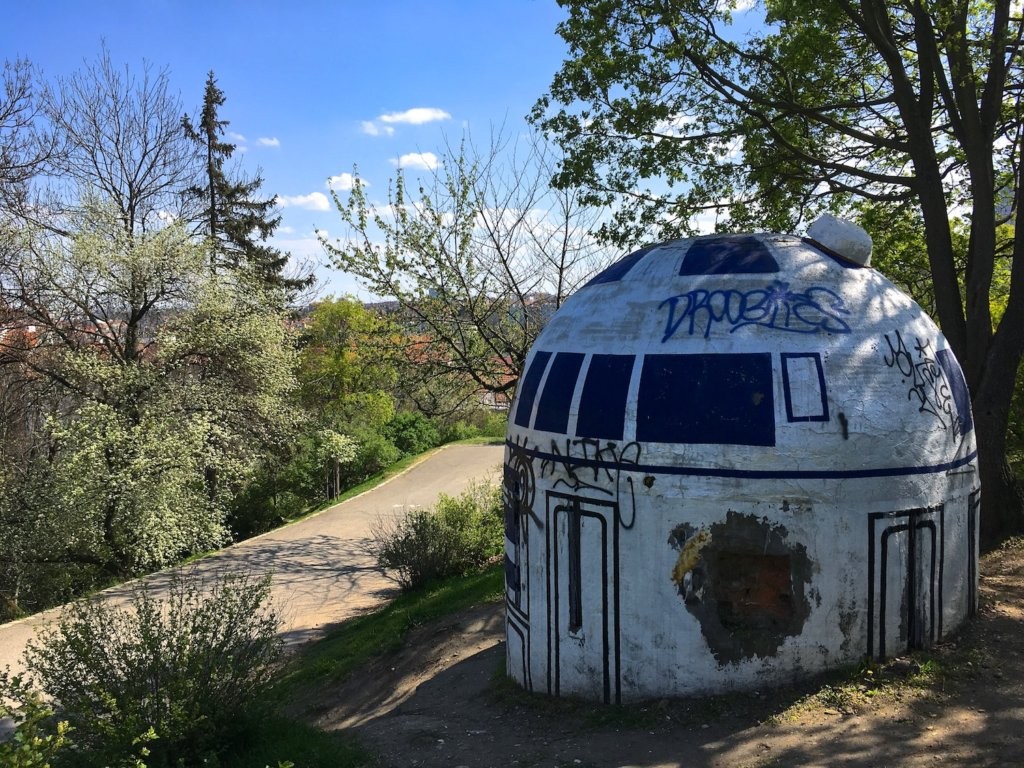 Statue of R2-D2 created by unknown street artists by redecorating a ventilation shaft connected to an abandoned nuclear bunker in Folimanka Park, Prague, Czech Republic
Statue of R2-D2 created by unknown street artists by redecorating a ventilation shaft connected to an abandoned nuclear bunker in Folimanka Park, Prague, Czech Republic
Bonus: Dark Tourism Day Trips from Prague
Enhance your dark tourism Prague experience with day trips to nearby historical sites. These destinations offer further insights into the region’s complex past and are easily accessible from Prague:
What dark tourism day trips can you take from Prague?
- Terezín Ghetto & Concentration Camp: A Nazi propaganda trip about 45 minutes by bus from Prague.
- Lidice: A village just outside of Prague that was wiped off the map by the Nazis during WWII.
- Sedlec Ossuary: A famous bone church about 45 minutes by train from Prague where the remains of 40,000+ people have been integrated into the church’s interior.
Planning a dark tourism trip to Prague can be complex, but SIXT.VN is here to assist. We offer personalized itinerary advice, airport transfer services, and hotel booking assistance tailored to your preferences. Navigate language and cultural barriers with our support, ensuring a smooth and enriching travel experience.
Ready to explore the dark side of Prague? Contact SIXT.VN today to start planning your historical adventure!
Address: 260 Cau Giay, Hanoi, Vietnam
Hotline/Whatsapp: +84 986 244 358
Website: SIXT.VN
FAQ About Dark Tourism Prague
What exactly is dark tourism?
Dark tourism involves visiting sites associated with death, tragedy, or suffering. It provides a way to learn about and reflect on difficult historical events.
Why is Prague a popular destination for dark tourism?
Prague has a rich and often turbulent history marked by wars, occupations, and political upheaval, resulting in numerous sites of historical significance for dark tourism.
Is dark tourism respectful?
When approached with sensitivity and respect, dark tourism can be a meaningful way to remember and honor those who have suffered, as well as to learn from the past.
What are some ethical considerations for dark tourism?
It’s important to be respectful of the sites and the people affected by the events that occurred there, avoid sensationalizing tragedy, and support local communities through responsible tourism practices.
Can dark tourism be educational?
Yes, dark tourism can offer valuable educational opportunities, providing insights into historical events, human resilience, and the consequences of violence and oppression.
What types of sites are included in dark tourism Prague?
Sites include concentration camps, memorials, cemeteries, museums, and historical landmarks associated with conflict, oppression, and tragedy.
How can I ensure my dark tourism visit is respectful?
Do research ahead of time, dress modestly, avoid taking insensitive photos, and be mindful of the local customs and traditions.
Are there guided tours for dark tourism sites in Prague?
Yes, many guided tours are available that provide historical context and ensure a respectful visit to these sites.
What is the best time of year to visit dark tourism sites in Prague?
Most sites are open year-round, but visiting during the shoulder seasons (spring and fall) can offer milder weather and fewer crowds.
How can SIXT.VN help me plan my dark tourism trip to Prague?
SIXT.VN provides comprehensive travel services, including personalized itinerary advice, airport transfers, hotel booking assistance, and support for navigating language and cultural barriers.



